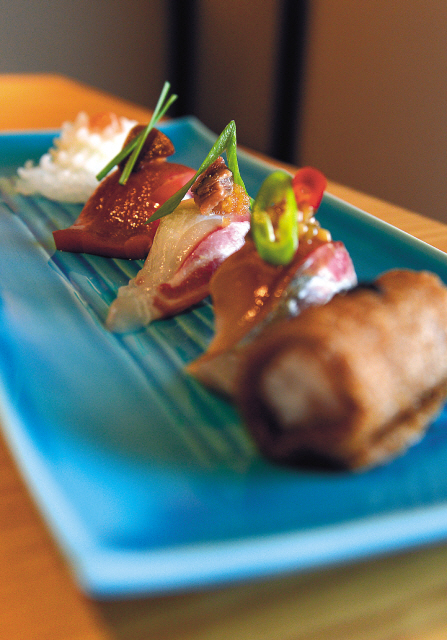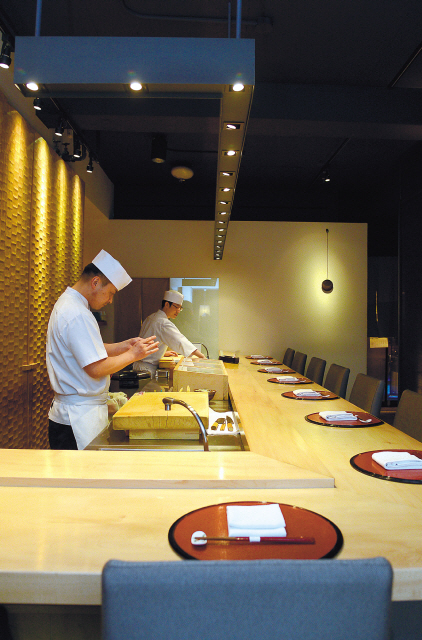Nouveau sushi at Tatsumi
Parade of transcendent bites reflects over 30 years of innovation
By Korea HeraldPublished : April 12, 2013 - 21:22
Modern sushi has evolved by leaps and bounds in Seoul over the past few years to the point where it is practically the norm.
Now, fish-obsessed diners can pick from a burgeoning crop of both high-end and wallet-friendly spots to satisfy cravings for sumptuous omakase meals where mouthwatering sushi is served piece by perfectly seasoned piece.
Now, fish-obsessed diners can pick from a burgeoning crop of both high-end and wallet-friendly spots to satisfy cravings for sumptuous omakase meals where mouthwatering sushi is served piece by perfectly seasoned piece.

A mere three years ago, that was not the case.
When Tatsumizushi quietly opened in Ichon-dong, Seoul, the restaurant was one of the first to present the concept of sushi as a thoughtfully timed parade of transcendent bites, brushed and adorned with specially crafted sauces and toppings designed to heighten and unearth the flavors of each cut of fish and seafood.
Then, one by one, more places opened, spreading the word about avant-garde sushi, and as that word spread, the Korean outpost of the Fukuoka-based sushi establishment matured and settled in, honing its craft silently and steadily.
“We are always working and researching,” head chef Maruyama Masamitsu, 42, explained how the art of finding that immaculate mouthful is never-ending.
The hard work has paid off.
Now a fixture of the Korean sushi scene, Tatsumizushi’s prix fixe meals are essentially a reflection of the culmination of around 20-plus years of innovative sushi-making experience; a journey that began when owner-chef Matsuhata Taminobu, who was heading his first Fukuoka-based Tatsumizushi at the time, was prompted to do something new.

“We tend to think of sushi as generally being dipped in and seasoned with soy sauce and wasabi,” said Maruyama, who went on to explain how Matsuhata began to rethink sushi.
Matsuhata developed what Maruyama referred to as “creative sushi,” where each piece came with its own sauce and topping ― making him part of the early generation of sushi masters to riff off the traditional 1800s Edo-style nigiri sushi for something somewhat different.
Matsuhata was not alone in his desire for a new approach to sushi. According to Maruyama, modern sushi became noticeably prevalent throughout Japan approximately 20 years ago.
As masters in Japan and the world-at-large continued to experiment with sushi, Matsuhata went on to open three more spots in Fukuoka. Then, three years ago, the first Korean outlet opened.
Nearly invisible from its small niche in the residential area of Seoul’s Ichon-dong, Tatsumizushi continues what can now be considered a long-standing tradition of “creative sushi.”
From one of nine counter seats that hold sway over the small space, diners are able to watch head chef Maruyama and crew deftly brush and dab from a repertoire of around 14 sauces onto glistening cuts of tuna, snapper and other delicacies before carefully crowning each piece with its own topping and serving it with a thorough description to the diner.
All the diner has to do is deploy those chopsticks, pick up, admire and then savor each piece, no dipping or adjustments necessary.
At Tatsumizushi, even relatively common cuts like the mitra squid are taken to new heights. Dabbed with a sauce crafted from salt and ume (Japanese apricot) then topped with a final orb of ume sauce, the smooth, silken, aromatic bite mingles the sweet and sour flavors of the apricot with the natural sweetness of the squid itself.
A crystalline cut of Japanese halfbeak, with two stripes of its iridescent skin left on, is brushed with a salt and ume sauce, topped with grated, vinegary daikon radish and then adorned with “white” kelp. The effect is visually stunning, with the thinly sliced seaweed a veritable mossy agate-hued jewel over a sea of pearl white.
One bite unleashes the addictive brine of the kelp with the soft meatiness of the halfbeak.
A cut of tuna is paired with soy sauce-pickled garlic, snapper with anchovy and anago (salt-water eel) with pickled snapper entrails for a surprisingly harmonious meeting of flavors and textures, a meeting that reveals a deep understanding of the different facets to salty, sweet, sour and umami ― facets that include the brine of anchovy, the oddly mouth-puckering sugary qualities of ume and the ocean-rich umami that comes from seaweed.
Clearly, this is sushi that is not about show and flair. This is sushi that is understated, whose primary purpose is to orchestrate and amp up the true beauty of each ingredient that composes it without ever forgetting that the main cut of fish or seafood must take the lead.
Sous chef Lee Kyoung-hun shed some further light on the thinking that goes behind such pairings.
“The pickled garlic is used to top the tuna to act as a foil against the rich oiliness of the fish,” Lee, 33, explained, showing how each secondary ingredient plays a key supporting role in perfecting each piece.
All that careful thinking pays off, shining through in each painstakingly crafted bite.
Tatsumizushi
● 302-64, Ichon 1-dong, Yongsan-gu, Seoul / (02) 749-0712
● Open 11:30 a.m. to 2:30 p.m., 5:30 p.m. to 10:30 p.m. daily
● Reservations recommended
● Special lunch prix fixe (10 pieces of sushi, three dishes, egg custard, soup, dessert) costs 55,000 won, special dinner prix fixe 140,000 won
By Jean Oh (oh_jean@heraldcorp.com)
-
Articles by Korea Herald



![[Weekender] Geeks have never been so chic in Korea](http://res.heraldm.com/phpwas/restmb_idxmake.php?idx=644&simg=/content/image/2024/05/16/20240516050845_0.jpg&u=)


![[News Focus] Mystery deepens after hundreds of cat deaths in S. Korea](http://res.heraldm.com/phpwas/restmb_idxmake.php?idx=644&simg=/content/image/2024/05/17/20240517050800_0.jpg&u=)
![[Herald Interview] Byun Yo-han's 'unlikable' character is result of calculated acting](http://res.heraldm.com/phpwas/restmb_idxmake.php?idx=644&simg=/content/image/2024/05/16/20240516050855_0.jpg&u=)











